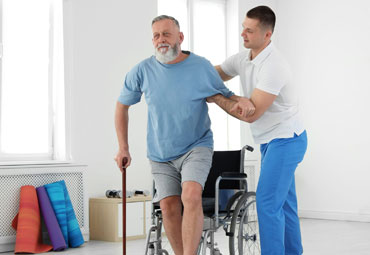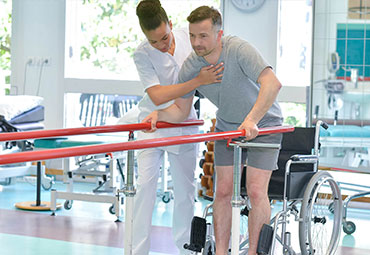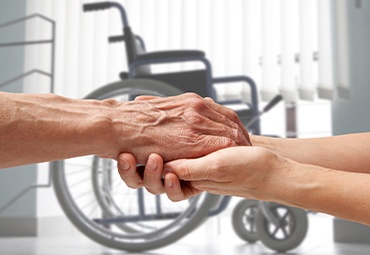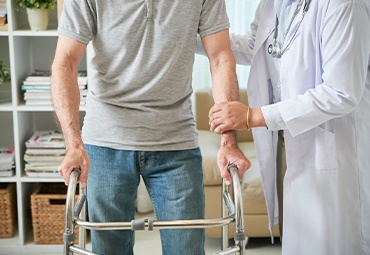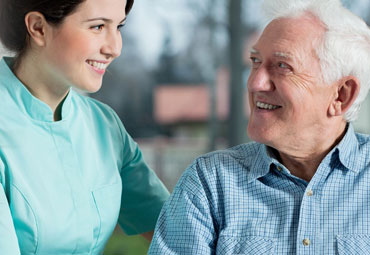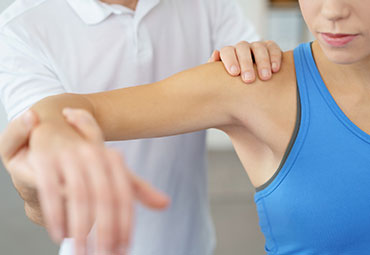
ParaplegiaAdaptive/Assistive Equipment: These are assistive devices that can be customised according to the need to enhance, maintain and improve mobility and capability of individuals with disability such as wheelchair, crutches, walker, splints etc.
Ambulate: Ability to walk without any kind of support.
AoDL / ADL– Activities of daily living. These are the functional skills required in daily life routine such as transferring,brushing, eating, buttoning, grooming etc.
Aphasia: Complete loss of speech due to stroke/brain injury or brain tumour.
Ataxia: Involuntary/uncoordinated movements due to abnormalities in different parts of nervous system.
Atrophy: Wasting of the muscle resulting in decrease in size of body part/organ.
Axonotmesis: Peripheral nerve injury causing loss of continuity of axons (2nd covering) resulting in axons division.
Bowel Movement: Body’s last process to flush out the waste material from the digestive system through anus.
CABG – Coronary artery bypass surgery.It is a surgical procedure performed for mostly TRIPLE VESSEL DISEASE(3 or more than 3 blocks). There is a bypass connection made to divert blood around blocked parts of major arteries to improve blood flow and oxygen supply to the heart.
Cerebellar Ataxia: Inability to coordinate balance, walking pattern, limb movements and eye movements due to damage occurred to cerebellum (major structure of the hind brain).
Contracture: Fixed tightening of muscle, joint, tendons or any tissue resulting in deformity is called contracture.
CVA: It is a medical term for STROKE. Obstruction in the blood flow(ischemic) or a rupture of an artery (haemorrhagic) resulting to permanent damage in the brain is called Cerebrovascular Accident (CVA).
Diplegia: It is symmetrical loss of strength usually affecting both arms or both legs and also both sides of face.
Dysarthria: It is a speech disorder wherein there is difficulty in pronunciation and articulation of words/sentences.
Dysphasia: Inability to speak language properly due to brain injury/disease. There are two types of dysphasia: Expressive dysphagia and Receptive dysphagia
Expressive Dysphasia: They can understand but have difficulty in expressing.
Gait Disturbance: Any deviation from the normal pattern of walking (Heel-Toe) is called gait disturbance.
Gait Training: It is a training program designed to make you learn how to walk in a correct pattern (Heel-Toe) post injury or paralysis.
Hematoma: Presence of blood clot in surrounding tissues, organ or body space due to damaged blood vessel.
Hemiparesis: Partial loss of strength in one side of arm, trunk, leg, face resulting in the weakness of one side of body due to brain damage/disease.
Monoplegia: It is loss of strength of only one limb such as an arm, a leg due to damage to a part of nervous system.
Neuroplasticity: Ability of the brain to reorganize itself to compensate the damage occurred and adjust to new situations/changes in environment. It is also known as “Brain Plasticity”/ “Brain Remodelling”
Neuropraxia: Peripheral nerve injury causing local myelin damage (1st covering) usually due to compression/stretch causing conduction block.
Neurotmesis: Peripheral nerve injury causing complete disruption of nerve (3nd covering) resulting in nerve division.
Paraplegia: Paraplegia refers to a complete loss of strength from lower trunk till down the legs(both) caused due to spinal cord injury mostly or damage to spinal column (vertebrae and disk).
Proprioception: It is nothing but joint sensation. Ability to sense movement and body position.
Quadriplegia/Tetraplegia: Complete loss of strength from neck down till legs (including arm, trunk) caused due to brain damage/injury or spinal cord injury (mostly C5-C7level). (see Quadriplegia vs Paraplegia)
Receptive Dysphasia: They will be able to speak fluently but maybe they use non sensical or irrelevant words or phrases. They may also have difficulty in understanding.
Seizure: Sudden Uncontrolled electrical discharges from the brain cells that causes temporary abnormalities in muscle tone, behaviours, sensations or state of awareness.
Spasticity: Increased in a tone of one particular group of muscles caused due to brain injury/disease or spinal cord injury.
SpO2: It is known as oxygen saturation. It is a measure of the amount of oxygen-carrying haemoglobin in the blood relative to the amount of haemoglobin not carrying oxygen. The body needs there to be a certain level of oxygen in the blood or it will not function as efficiently.
Tremors: Involuntary / Uncontrollable shaking of extremities worsening while doing any voluntary action.
Urinary Incontinence: Inability to control urine either partially (loss of drips of urine while sneezing/coughing/laughing) or completely.






